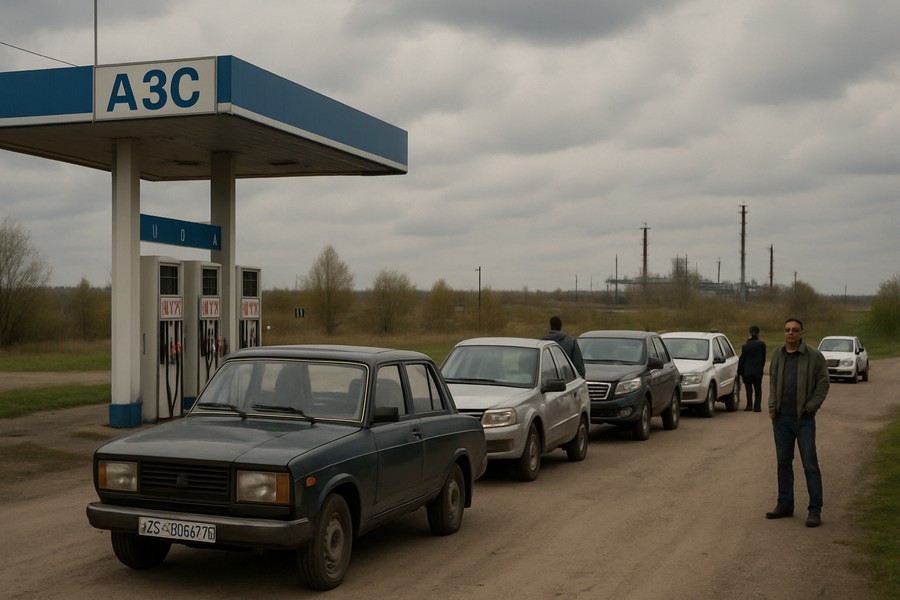
Shortage of Fuel in Certain Russian Areas as Ukrainian Drone Strikes Hit Oil Refineries
Due to recent attacks on oil refineries by Ukrainian drones, some areas of Russia are experiencing a shortage of fuel. This has caused long lines at gas stations, and in some instances, authorities have had to ration fuel or stop sales altogether.
The lack of fuel has led to a significant increase in wholesale prices, particularly for high-octane A-95 gas. Prices have risen about 50% since the beginning of the year, fueled by the increased demand from farmers for the harvest season and the summer travel rush.
Impacted Regions
Reports suggest that the fuel crisis is affecting consumers in the Far East regions of Russia and the Crimean Peninsula, which was taken over by Russia from Ukraine in 2014. In the Primorye region, which shares a border with North Korea, gas stations are selling fuel for nearly $3.58 per gallon, a hefty price for an area where the average monthly wage is around $1,200. Other drivers have been spotted trying to sell fuel online for a whopping $10.12 per gallon.
In the Kurilsky district of the Kuril Islands, north of Japan, the shortage of A-92 gas, a lower octane fuel, has forced officials to halt public sales. In Crimea, a favorite vacation spot, some businesses are selling fuel only to individuals with coupons or special cards.
Increased Attacks on Oil Refineries
While Russia often experiences a rise in gasoline prices at the end of summer, this year's scarcity has been worsened by increased attacks on oil refineries by Ukraine amid the ongoing war. These attacks, which are larger and more concentrated, are causing more damage and disrupting production during peak demand.
Ukraine has targeted energy infrastructure in the past, but the recent strikes have been more successful. The attacks are primarily focused on a group of refineries stretching from Ryazan, south of Moscow, to Volgograd, which is a popular route for vacationers traveling to the Black Sea resorts and a busy area for harvest operations. It's also a densely populated region.
Between the beginning and end of August, Ukraine attacked oil infrastructure at least 12 times. Out of these attacks, at least 10 targeted sites in the Ryazan-Volgograd arc in southwestern Russia. These attacks have damaged many oil refineries, but have not destroyed them completely. However, they have slowed down refinery operations, leading to a decrease in the intake of crude oil for diesel and gasoline production.
Additional Challenges
Apart from the refinery attacks, other war-related issues have added to the consumer's woes. Ukrainian drone strikes have frequently disrupted Russian transportation networks, especially air traffic. This has led to an increased number of people traveling by car and thus, increased demand for gas.
Inflation has also made it less profitable for suppliers who usually purchase gasoline early in the year for sale during the high-priced summer months. As a result, many entrepreneurs have chosen not to engage in this business this year.
Although each of these issues individually may not have caused a widespread disruption, their combined effect has turned an expected annual price fluctuation into a significant problem for the government.
Measures to Address the Shortage
To alleviate the shortage, Russia paused gasoline exports at the end of July, with plans to extend the restriction into September. Oil company executives have been called to government meetings to discuss the shortages.
Despite these challenges, the fuel shortage is not considered critical. The shortage is restricted to certain areas like the Far East and Crimea, as these regions are usually supplied by fewer refineries and have greater transportation demands. Moscow has remained unaffected by the latest gasoline price surge due to the presence of major refineries in nearby cities and within the city itself.
Although the situation could potentially worsen, experts believe that Russia is not at immediate risk of coming to a standstill. While private drivers may feel the pinch at the gas pump, most buses and trucks run on diesel, which Russia has in surplus. The military, which largely uses diesel fuel, is also protected from any shocks.
However, this crisis underscores a vulnerability that could be exploited further as drone warfare evolves. The fuel crisis is expected to ease by late September as demand decreases and annual summer maintenance for many refineries is completed.
